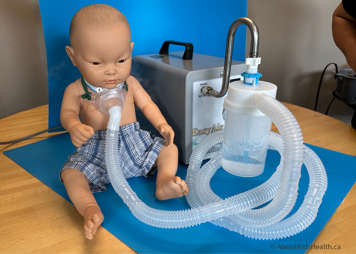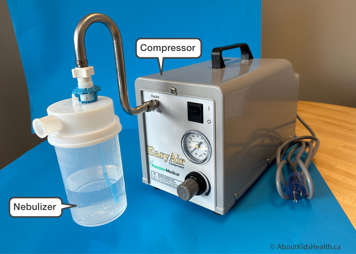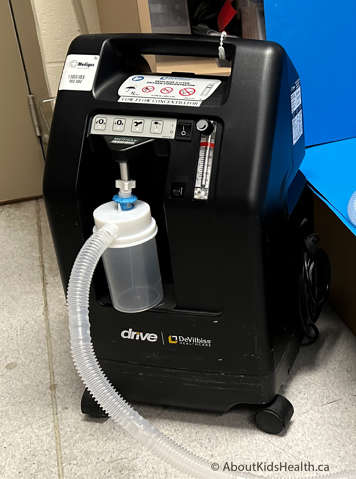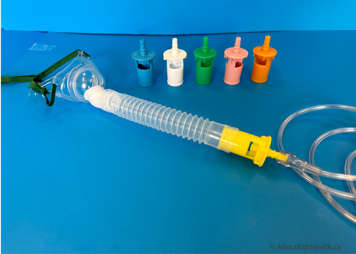At the end of this page, you will be able to:
- describe how a non-heated humidifier works
In a non-heated humidification system, the air is humidified, or moistened, but is not warmed. If necessary, your child can also receive oxygen through this humidification system.

How does a non-heated humidifier work?
A non-heated humidifier (cool humidity) consists of a compressor and a nebulizer. Mist is formed as air passes into a nebulizer bottle with water. This mist travels through tubing to a mask that goes over the tracheostomy tube.

Types of non-heated humidifiers
There are different brands and sizes of non-heated humidifiers available, depending on your child's needs, including the ones below:
-

Devilbiss 5-Litre Oxygen concentrator
-

Philips Everflo
Precautions
- Over-hydration (too much water) can lead to increased suctioning.
- If secretions are already thick and stuck, humidification can sometimes cause them to expand and block the airway.
- Never drain the water from the tubing into the nebulizer bottle.
- Always have the tubing below the child to prevent condensed water from flowing into the child or accidentally getting inhaled.
How do I assemble a non-heated humidifier?
Before you start
Gather your supplies:
- sterile, distilled water (fill water below maximum fill line on water bottle)
- large volume nebulizer bottle
- corrugated aerosol tubing
- tracheostomy mask/collar
- high pressure compressor

Oxygen can be added to the high pressure (or heavy-duty) compressor by a concentrator or other oxygen source.
Assembling the non-heated humidifier
- Wash your hands.
- Fill the nebulizer bottle with sterile, distilled water.
-

Make sure you properly align the nebulizer bottle with the high-pressure/heavy duty compressor connection. If the plastic threads on the nebulizer bottle are not aligned properly, the bottle will not connect securely.
- Attach the corrugated tubing to the nebulizer bottle.
-

Humidified aerosolized tracheostomy mask with a Venturi oxygen adaptor. Attach the tracheostomy mask to the other end of the corrugated aerosol tubing.
- Turn the high-pressure compressor to ON. A fine mist should start moving through the corrugated tubing and come out through the tracheostomy mask.
-

Place the tracheostomy mask over the tracheostomy tube.
- Monitor your child’s work of breathing and watch for any signs of discomfort.
- Watch for condensation (water) that will build up in the tubing. If water builds up, disconnect the tubing from the mask and drain into a garbage bin. Do not attempt to guide the water back into the water canister.
- Check the tubing frequently and drain any water build-up. If you are seeing a lot of water build-up, speak to your health-care team or vendor for advice on how to decrease this.
How often should I clean or change the non-heated humidifier equipment?
Weekly
Clean the following items with soap and water or replace as indicated:
- nebulizer bottle
- replace the disposable corrugated tubing
- tracheostomy mask - wash weekly
Monthly
Change the following items:
- replace nebulizer bottle
- replace tracheostomy mask (or more often if soiled/broken)
How do I fix a problem with the non-heated humidifier?
If there is not enough mist coming out of the nebulizer bottle, the non-heated humidifier is not working properly. To fix the problem:
- make sure the nebulizer bottle has enough sterile, distilled water
- check that the tube inside the nebulizer bottle is not kinked or obstructed
- check that the nebulizer bottle lid is threaded on correctly
If the problem is still not fixed, contact your home care company or respiratory vendor.
Precautions
Remember to frequently drain the water build-up in the tubing. Draining the tubing frequently prevents the water from getting accidentally inhaled if the tubing is tipped towards the child.
To drain the water, disconnect the tubing at the end that is connected to the tracheostomy mask and discard the water into a toilet or sink.
The table below describes the various oxygen and humidity set-up options that you may need. For more information on oxygen systems, please see the chapter Types of home oxygen therapy systems.
| Oxygen and humidity setup options | Humidity setup | Oxygen setup |
|---|---|---|
| Trach mask with humidity and oxygen | Aerosol via heavy duty compressor | Via concentrator or tank.
Use Venturi device if specific oxygen amount is desired. |
| Trach mask with humidity and oxygen | Aerosol via heavy duty compressor | Oxygen added directly into heavy duty compressor |
| Trach mask with oxygen only | Water bottle attached to concentrator | |
| Trach mask with humidity and oxygen for travel | HME | Add oxygen using a Venturi connector |
| Trach mask with nebulizer; no oxygen needed | Nebulization can be from either a:
| |
| Trach mask with nebulizer with oxygen needed | Put nebulizer tubing directly to a concentrator or oxygen tank (or another oxygen source) | |
| HME only, no oxygen needed for travel | HME directly onto tracheostomy tube | No oxygen needed |
| Large HME with oxygen for travel | HME | Oxygen adaptor if large HME |
| Small HME with oxygen for travel | HME | Trach mask with Venturi |
| Small HME where O2 is needed but the HME doesn’t come with an O2 adaptor | Small HME | Trach mask connected directly to an oxygen source. A Venturi device can be used if looking for a specific amount of prescribed oxygen.
Reminder: do not use humidity with the oxygen (e.g. a nebulizer) as you already have humidity from the HME. |
For information on Airvo, please see the page Heated high-flow humidity for tracheostomy